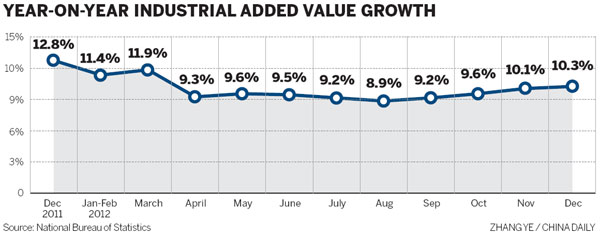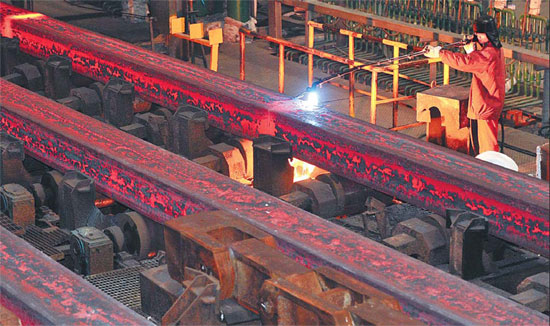Industrial output target set
Updated: 2013-01-24 06:01
By Zheng Yangpeng (China Daily)
|
||||||||
|
An alloy steel production line at a special-steel mill in Dalian, Liaoning province. China's industrial added value registered 10 percent growth in 2012 and is expected to stay at the same level this year, according to the Ministry of Industry and Information Technology. Liu Debin / For China Daily |
M&A activities encouraged to tackle sectors' overcapacity, say guidelines
China has set a cautious industrial output target for 2013, as the top industrial regulator beat the drum once again on industry consolidation to tackle overcapacity.
The Ministry of Industry and Information Technology is targeting 10 percent growth in industrial output this year, unchanged from last year's target, said Zhu Hongren, the ministry's spokesman, at a news conference on Wednesday.
Zhu said the target takes into account the changed industrial environment this year, its relation with GDP growth, and the internal cycle of the industrial economy.
"External demand will not recover in the short term, and the growth of domestic demand is constrained by several factors. Under this circumstances, it will not be easy to achieve the target in real terms," said Zhu.
China's industrial output rose 10 percent year-on-year in 2012, much lower than the previous year's 13.9 percent increase.
Industrial output growth slowed to 9.5 percent in the second quarter from 11.6 percent in the first, and further dipped to 9.1 percent in the third quarter, before it rebounded to 10 percent in the fourth.
Alaistair Chan, an economist with Moody's Analytics, said the country's industrial output growth would likely be slightly higher in the first half of the year, before slipping again in the second half, as the current growth base is weak and there isn't a strong-enough stimulus package from the government in place to maintain the momentum.
Meanwhile, overcapacity will keep haunting several heavy industries, Chan added.
For instance, China's machinery industry's output only grew 8.4 percent in 2012, compared with the 15.1 percent growth in 2011.
And China's steel industry had about 160 million metric tons of excess production in 2012, while 33.8 percent of China's steel plants are suffering from losses.
The Ministry of Industry and Information Technology has said it supports increased mergers and acquisitions to tackle overcapacity.
On Tuesday, the ministry - along with 11 other governmental bodies - issued a guideline, saying the government encourages M&A activity in the auto, steel, cement, shipbuilding, electrolytic aluminum, rare earths, electronic information, pharmaceutical and agricultural sectors.
In the auto sector, for instance, the guidelines call for the production of the top 10 automakers to account for 90 percent of the industry's total output.
But analysts said that authorities have been advocating higher industrial consolidation for years with limited results. They added that the M&A encouragements get stronger when the industrial sectors face a downturn.
"The main problem is that the companies are not interested," said Zhang Lin, an analyst with Lange Steel Information Research Center.
"Most of China's large steel companies' core business is in the red. They lack the capital to merge with other companies. And the equipment and technology of small steel companies are generally poor, making them unattractive to large companies," Zhang said.
Regional protectionism is another major reason stifling M&A activity, said Wei Zengmin, an analyst with industrial consultancy Mysteel.
According to Wei, steel companies contribute a sizable portion of local GDP and fiscal revenue, making cross-regional mergers difficult.
The central government is aware of these obstacles.
Zhu, the ministry spokesman, stressed at Wednesday's news conference that in the M&A process, companies should play a major role.
"Governments cannot make matches for M&A deals. Instead, they should create a fair environment, which includes removing some of the institutional barriers for M&A," Zhu said.
zhengyangpeng@chinadaily.com.cn

(China Daily 01/24/2013 page13)

 In Photos: 7.0-magnitude quake hits Sichuan
In Photos: 7.0-magnitude quake hits Sichuan
 Li Na on Time cover, makes influential 100 list
Li Na on Time cover, makes influential 100 list
 FBI releases photos of 2 Boston bombings suspects
FBI releases photos of 2 Boston bombings suspects
 World's wackiest hairstyles
World's wackiest hairstyles
 Sandstorms strike Northwest China
Sandstorms strike Northwest China
 Never-seen photos of Madonna on display
Never-seen photos of Madonna on display
 H7N9 outbreak linked to waterfowl migration
H7N9 outbreak linked to waterfowl migration
 Dozens feared dead in Texas plant blast
Dozens feared dead in Texas plant blast
Most Viewed
Editor's Picks

|

|

|

|

|

|
Today's Top News
Live report: 7.0-magnitude quake hits Sichuan, heavy casualties feared
Boston suspect cornered on boat
Cross-talk artist helps to spread the word
'Green' awareness levels drop in Beijing
Palace Museum spruces up
First couple on Time's list of most influential
H7N9 flu transmission studied
Trading channels 'need to broaden'
US Weekly

|

|








